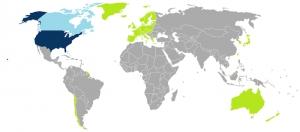
Legal Immigration To The United States Through Family Petitions
Family reunification has always been an important concept within immigration law. However, helping people enter the United States (USA) based on a family relationship can be difficult and complex. Specific understanding of the interpretations, definitions, quotas, deadlines, and interaction of numerous provisions on immigration law is now more important than ever. The purpose of this article is to provide immigrants with an overview of the selection system through family petitions.
The U.S. government provides 226,000 immigrant visas annually through family petitions. These petitions are the most common mechanisms by which the immigrant can obtain a green card in the United States. Family petitions are divided into two main categories: 1. Immediate Family Members and 2. Preferential Family Members.
1. Immediate Relatives do not have to wait for a family visa to be available, nor are they subject to any annual visa quota or percentage. In short, these immigrant visas are quickly granted (7-9 months) by the US Citizenship and Immigration Service (USCIS). The people eligible for this category of family petitions are the following:
- Spouses of American citizens.
- Widows of American citizens.
- Unmarried children under 21 years of age of an American citizen.
- Parents of American citizens, if the son/daughter is over 21 years old.
- Adoptive children of American citizens as long as the children are adopted before they are 16 years old.
- Stepchildren (under 21 years old) or stepparents/stepmothers of American citizens as long as the stepchild/stepparent relationship has been established before the stepchild is 18 years old.
2. Preferred Family Members have a system by which, according to the priority in which they are considered, they must necessarily have a petition formulated and then wait for the USCIS to determine the availability of resident visas before one is granted. The waiting list is often many years because the US government has established an annual limit number per country for people who must obtain permanent residence in this category. The US government publishes the Visa Bulletin monthly, which reports the availability dates of visas in chronological order, by country, for the different categories of family petitions. The different groups of Preferred Relatives are the following:
- First Preference: Children of American citizens, single and over 21 years old. Currently, there is an annual quota of 23,400 visas and the waiting list is more or less 7 years.
- Second Preference :
- Second Preference (A): Spouses and children of permanent residents.
- Second Preference (B): Children over 21 years of permanent residents, as long as they are single.
The annual fee for this category is 114,200 visas and the waiting list is 2-3 years for Second Preference A and 7-8 years for Second Preference B.
- Third Preference: Children of American citizens, married and over 21 years old. The annual fee is 23,400 visas and the waiting list is more or less 10 years.
- Fourth Preference: Siblings of American citizens, as long as the citizen is over 21 years old. The annual fee is 65,000 visas and the waiting list is more or less 11-12 years.
Application Process: Family petitions are requested with the I-130 immigration form. The US citizen or permanent resident who makes the petition is known as the Petitioner, while the foreign relative who will obtain permanent residence is known as the Beneficiary.
Consular Process: If the Beneficiary is outside the United States, he will apply for permanent residence to an American consul in his country of residence, or in any other country where the Beneficiary is living. In this circumstance, the Petitioner must sign Form I-130 and send it, along with other documents that support the family relationship with the Beneficiary. In addition, the Petitioner must attach payment for the petition (currently $ 420). The instructions on Form I-130 indicate the specific documents that must be attached to the petition, as well as the address where the petition must be submitted.
Once the petition is submitted, USCIS approves the petition and sends it to the National Visa Center (NVC) in New Hampshire. If the Beneficiary is an immediate family member or a preferred family member with visa available according to the Visa Bulletin, the NVC will send a new package of papers to the Petitioner. The Submitter will have to make the corresponding payment ($ 88 per support form + $ 404 for each beneficiary included in the petition) and send new forms (I-864, DS-3032, DS-230 Parts I & II) to the NVC. In addition, the Petitioner must obtain certain documents from the Beneficiary, which will be required for the residency interview (copies of the passport, criminal and judicial records, passport size photos). Once the payment and documentation are received and reviewed by the NVC, the case will be sent to the American Consulate,
The American Consulate will request the Beneficiary to undergo the corresponding medical examination before the interview. If everything is in order, the Beneficiary will receive his immigrant visa, as well as any other family member who has also been included in the petition. The Beneficiary will then have a period of six months in which he must travel to the USA. so that your passport is stamped and be admitted as a permanent resident.
Adjustment of Status: If the Beneficiary were within the US, they could qualify for an Adjustment of Status with the USCIS and have their interview in the USA. Without the need to travel to an American Consulate outside the US Usually if the Beneficiary entered the US legally with non-immigrant status (with tourist visa, work, etc.) and, in turn, is an immediate relative or a preferential relative with an approved I-130 petition and visa available according to the Visa Bulletin, this may request USCIS to adjust your permanent resident status using form I-485.
Adjustment of Status is not available to people who have entered the US illegally (without a visa). However, the Immigration and Naturalization Act (INA) provides an exception and allows Adjustment of Status, under section INA 245 (i), to Beneficiaries who have entered the US illegally. before December 21, 2000, and who also had a family (or employment) petition filed on their behalf before April 30, 2001. Persons who qualify for this exception will need to file Form I-485A (in addition Form I-485), along with a $ 1,000 fine.
Through Adjustment of Status, the Beneficiary [of an immediate family petition (I-130) or of an already approved preferential family petition with visas available in their category] will submit the application for residency (I-485). The Beneficiary must include the necessary documentation to demonstrate their eligibility to be a legal resident in the USA. Among the evidence that the Beneficiary has to present are: evidence of the family relationship with the Petitioner; a medical examination; passport size photographs; certified copies of divorces; certified copies of arrests and criminal records; Biographical Data Form (G-325A) and a Support Form (I-864), completed by the Submitter to demonstrate that the Beneficiary will not be a public charge to the US Further, the Beneficiary will have to attach the application fee (currently $ 1,070). It is important to emphasize that the Adjustment of Status allows the Beneficiary to acquire a work permit at no cost, through form I-765, while he waits for his interview.
Completed the preliminary process by the USCIS, the Beneficiary will be summoned for their respective interview in a USCIS office. During the interview, the petition and application for residency will be reviewed and, if the petition is based on a marriage, there is the possibility that the interviewees (Petitioner and Beneficiary) will be questioned separately by the immigration examiner in order to certify the validity marriage, in order to avoid documentary fraud; which can mean, a deportation or civil and criminal penalties, both for the Beneficiary and for the Petitioner.
In the specific case of family petitions for marriage, it is very important that the interviewees carry proof that the marriage is true, examples: tax returns and payments, joint accounts, insurance policies, wills, powers of attorney, photos, certificates of children born within of marriage, etc. It is very important to know that, during the interview, the USCIS requires that the interviewees have original documents.
If everything is in order, the Adjustment of Status will be accepted and the residence certification will be stamped in the Beneficiary’s passport, likewise, the residence card will be mailed within a few weeks. Once the Adjustment of Status is approved, the Beneficiary is officially a permanent resident and can therefore travel outside of the US and you are allowed to work while you wait to receive your card.
Due to the decentralization of DHS, lately the Adjustment of Status processes are not taking as long as before (usually the process takes 4-6 months). Many times the work permit arrives days before the notification for the Adjustment of Status interview. However, the procedures for each USCIS office are different; therefore it is important to check with each office to determine the method of processing cases.

